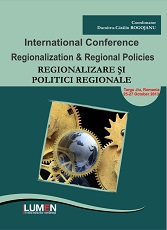Disparităţi şi tendinţe în dezvoltarea regională: un model nelinear de simulare
Disparities and trends in regional development: a non-linear simulation model
Author(s): Lucian-Liviu Albu
Subject(s): Politics / Political Sciences
Published by: Editura Lumen, Asociatia Lumen
Keywords: Non-linear simulation model; variation coefficient; recursive procedure; convergence; divergence;
Summary/Abstract: There are many debates in the literature on the estimation of the convergence trend . The authors use a variety of methods and indicators in this respect. In this study, taking into account one of the consequences of the standard convergence theory (which states simply that in the long run as income per capita increases its growth rate decreases) and using actual existing data, we are trying to estimate a theoretical (hypothetical) trend optimally with respect to certain rational criteria. Specifically, we impose to the simulation model, which is operating for each constituent entity of a group, the requirement that the total estimated revenue in the last year of a period to be equal to the total actual recorded income in that year or the total estimated income of the group for the whole considered period to be equal to the total actual income of the group for the same period. In this way, the simulation model used to estimate parameters will be subject to actual statistics. After the description of a non-linear theoretical model, we estimate its basic indicators by a recursive procedure, both in case of two groups of countries in EU and also in case of Romanian economy composed by eight regions. Then, study is focussing on the analyses of the gap between real convergence (divergence) and optimal trend of convergence.
Book: Regionalizare şi politici regionale
- Page Range: 253-273
- Page Count: 21
- Publication Year: 2014
- Language: Romanian
- Content File-PDF

